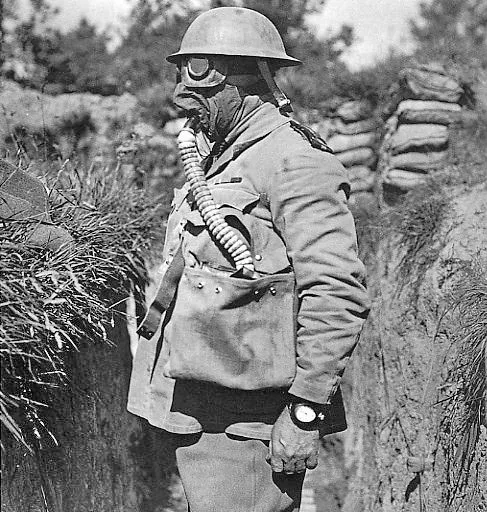To Protect Allied WWI Soldiers, This Researcher Tested an Early Gas Mask on Himself
John Haldane developed a rudimentary respirator that protected wearers against chlorine gas—at least for a few minutes
/https://tf-cmsv2-smithsonianmag-media.s3.amazonaws.com/filer/f9/c8/f9c8f35e-c24a-46ce-b7be-ff154db7e589/haldane_in_his_laboratory_at_oxford_1911crop.jpg)
Editor’s Note, May 11, 2022: This article previously suggested that John Haldane was the first person to invent a gas mask. In fact, Garrett Morgan, a Black inventor based in Ohio, filed a patent for a gas mask in 1914, a year before Haldane started researching his device. The story has been updated to reflect Morgan’s contributions.
Unprepared for German forces to use chlorine gas as a weapon, many Allied soldiers suffocated, unprotected, during the Battle of Ypres in 1915.
But they gained protection thanks to the efforts of scientists who worked on the home front. One of these scientists was John Scott Haldane, whose spectacular moustache (see above) would likely have prevented him from getting a good seal when wearing a gas mask.
Haldane, born on this day in 1860 in Edinburgh, Scotland, got his medical degree in 1884. But he wasn’t a practicing doctor: instead he was a medical researcher, writes the Science Museum in London. He taught at several universities and developed medical remedies for common industrial ailments. Haldane’s particular project was mining. Smithsonian has written about Haldane before, because he was the man who devised the idea of using canaries and other small animals in coal mines to detect odorless, deadly gases. He had also done previous work on how to protect miners from gas using respirators, according to Jerry Chester for the BBC.
But Haldane’s other big contribution didn’t just endanger birds: It endangered him and his family. Thirty years into his career, in 1915, Haldane was sent to Ypres after the battle, the BBC writes.
His job was to ID the kind of gas that was being used. Haldane and his team were able to identify the gas used at Ypres as chlorine by examining discolored metal buttons on soldiers' uniforms.
After he returned to his home in Oxford, England, he started experimenting to find out what would keep the gas out. On himself. And his family.
The scientist’s lab was in his home, and he employed his daughter Naomi, then a teenager, as a research assistant, historian Steve Sturdy told the BBC. Haldane and his fellow researchers would expose themselves to gas and test its effects.
“Naomi was stationed outside the door, which had a window in it, with instructions that if any of them were incapacitated she should get them out as quickly as possible and perform artificial respiration on them,” Sturdy says.
Before Haldane and his team made innovations in keeping soldiers safe from gas, the suggested remedy on the front lines was holding a urine-soaked handkerchief or urine-soaked socks to the face, Chester writes.
Then Haldane’s first effort was a “makeshift” respirator, Sturdy told the BBC, called the “Black Veil” respirator. “Basically it was pads of cotton waste that were wrapped in gauze and soaked in a solution, sodium thiosulphate, which neutralized the effects of low concentrations of chlorine gas.
But it was far from a solution. One stretcher bearer quoted in Chester’s article described being among the first to use the veil respirator:
But, I found using it in the gas cloud that after a couple of minutes one couldn't breathe and so it was pushed up over the forehead and we swallowed the gas.
It was not a practical proposition at all.
As the frequency and concentration of gas attacks grew, the technology needed to change. Though Black inventor Garrett Morgan had patented an early gas mask in 1914, a full year before Haldane began his work, Morgan’s device wasn’t designed for battle; instead, wrote Leo DeLuca for Scientific American in 2021, his safety hood was intended to protect workers from smoke and fumes. Due to racism, Morgan initially struggled to sell his product, but he found success after hiring white actors to pose as him at trade shows.

Haldane, for his part, helped to work on the box respirator, the direct ancestor of the modern gas mask. The box respirator was ultimately designed by another scientist, Edward Harrison, who died prematurely because of exposure to gas during testing.
“They were fighting a war in the laboratory at Oxford, and I think to understand what they were doing and the risks that they faced I think you need to understand the urgency of the situation that they saw themselves in,” Sturdy said.